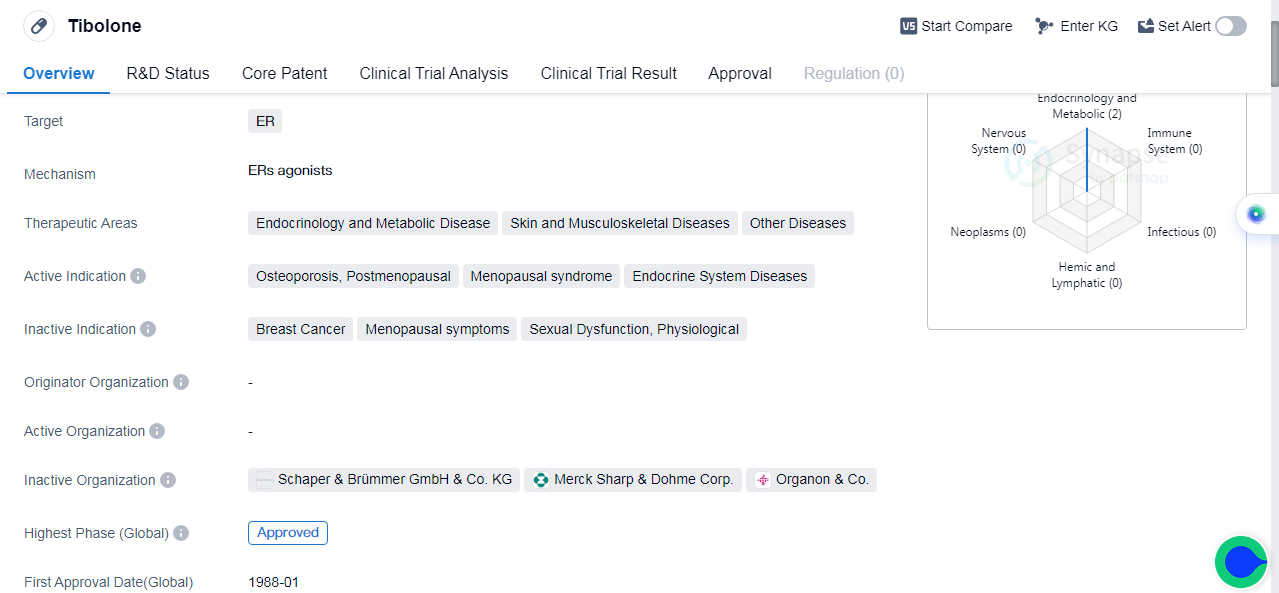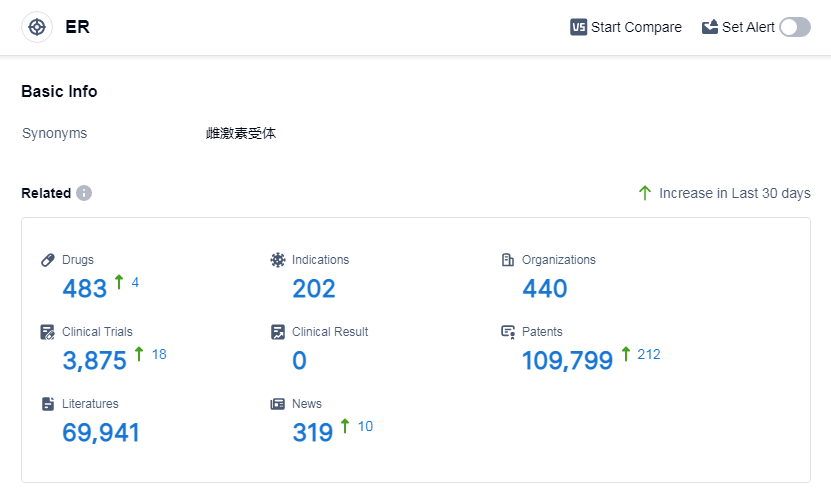Decoding Tibolone: A Comprehensive Study of its R&D Trends and Mechanism on Drug Target
Tibolone's R&D Progress
Tibolone is a small molecule drug that primarily targets the estrogen receptor (ER). It is used in the treatment of endocrinology and metabolic diseases, skin and musculoskeletal diseases, as well as other diseases. The drug is indicated for the treatment of osteoporosis in postmenopausal women, menopausal syndrome, and endocrine system diseases.
Tibolone was first approved globally in January 1988, and it has received approval for its highest phase of development globally.
As a small molecule drug, Tibolone is designed to interact with the estrogen receptor, which plays a crucial role in various physiological processes. By targeting estrogen receptor, Tibolone aims to provide therapeutic benefits in the treatment of osteoporosis, menopausal syndrome, and endocrine system diseases.
Osteoporosis is a condition characterized by the loss of bone density, leading to an increased risk of fractures. Tibolone is approved for the treatment of osteoporosis in postmenopausal women, who are particularly susceptible to this condition due to hormonal changes. By acting on the estrogen receptors, Tibolone may help to prevent further bone loss and reduce the risk of fractures.
Menopausal syndrome refers to a range of symptoms experienced by women during menopause, including hot flashes, night sweats, and mood swings. Tibolone is indicated for the treatment of these symptoms, potentially providing relief and improving the quality of life for menopausal women.
Endocrine system diseases encompass a wide range of conditions affecting the hormonal system. Tibolone's approval for this indication suggests its potential efficacy in managing such diseases.
👇Please click on the image below to directly access the latest data (R&D Status | Core Patent | Clinical Trial | Approval status in Global countries) of this drug.
Mechanism of Action for Tibolone: ERs agonists
ERs agonists refer to compounds or substances that bind to and activate the estrogen receptors (ERs). Estrogen receptors are proteins found in various tissues, including the reproductive organs, bones, and brain, that are involved in regulating the effects of estrogen hormones. ER agonists mimic the action of estrogen by binding to the ERs and triggering a cellular response.
From a biomedical perspective, ER agonists are of particular interest in the field of biomedicine as they can be used to modulate estrogen signaling pathways. They are commonly employed in hormone replacement therapy (HRT) to alleviate symptoms associated with menopause, such as hot flashes and vaginal dryness. Additionally, ER agonists may have potential applications in the treatment of certain hormone-dependent cancers, such as breast and ovarian cancer, by blocking the effects of estrogen on tumor growth.
It is important to note that the term "ERs agonists" does not specify a particular compound or drug, but rather represents a class of substances that activate estrogen receptors. Specific examples of ER agonists include selective estrogen receptor modulators (SERMs) such as tamoxifen and raloxifene, which have different effects on different tissues, and selective estrogen receptor degraders (SERDs) like fulvestrant, which can degrade the ER protein and inhibit its activity.
Drug Target R&D Trends for Tibolone
According to Patsnap Synapse, as of 5 Sep 2023, there are a total of 483 ER drugs worldwide, from 440 organizations, covering 202 indications, and conducting 3875 clinical trials.
The current competitive landscape of the target ER is characterized by the presence of companies such as Bayer AG, Pfizer Inc., and Mochida Pharmaceutical Co., Ltd. These companies have shown significant growth and R&D progress in developing drugs for the target ER. Small molecule drugs and PROTACs are the drug types that are progressing most rapidly. China is one of the leading countries/locations in drug development for the target ER, with a high number of approved drugs and ongoing research efforts. Overall, the target ER presents a competitive landscape with promising future development potential.
👇Please click on the picture link below for free registration or log in directly if you have a freemium account, you can browse the latest research progress on drugs, indications, organizations, clinical trials, clinical results, and drug patents related to this target
Conclusion
In summary, Tibolone is a small molecule drug that targets the estrogen receptor and is approved for the treatment of osteoporosis, menopausal syndrome, and endocrine system diseases. Its approval in the global market highlights its established presence in the pharmaceutical industry.






